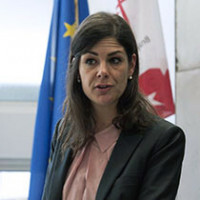 In the second issue of our newsletter, we interviewed Dr Costanza HERMANIN, visiting professor at the College of Europe and trainer of the course “Managing Migration in Europe – challenges and responses”.
In the second issue of our newsletter, we interviewed Dr Costanza HERMANIN, visiting professor at the College of Europe and trainer of the course “Managing Migration in Europe – challenges and responses”.
How is migration management being reshaped by the New Pact on Migration and Asylum in your opinion?
The New Pact on Migration and Asylum has never been really “new” and is unfortunately already old. The few innovations it contains, e.g., a solidarity key based on GDP and return sponsorships, make it a middle-to-low denominator package. Nonetheless, progress in the negotiations since its adoption has been little. One reason is the lowered pressure at the southern borders of Europe during COVID, and the de-politicisation of migration due to the pandemic. For two years, migration has not been a priority anymore. Second, the war against Ukraine has been a good pretext for more reluctant Member States to delay progress on the Pact, while they provided support for people displaced from Ukraine. Today, the recurring challenges are back, with arrivals from the South that have more than doubled since 2022. Toxic politics has returned, and the Pact may have become too old.
What do you think is the main challenge for the EU when it comes to migration management?
The main challenge for migration management is toxic politics. When it comes to Dublin reform, humanitarian corridors, etc., good technical solutions are on the table, and they do not change much from one Commission proposal to the next. In addition, there is no tackling the crises related to asylum and irregular arrivals, without addressing the need to have channels for labour migration. When it comes to the reform of the Dublin system and the application of the solidarity principle, everything lays with the goodwill of political leaders. COVID put the issue under the carpet, but the new situation of arrivals in Italy shows the total lack of progress so far. In the latest State of the Union, Dublin did not even get a mention in the President’s speech, and neither did the topic overall, with the exception of stressing the need for a common approach to recognising the qualifications for third country nationals seeking work in the EU. And yet, we are back to square one with people fleeing Libya who cannot disembark in European ports.
The executive education course Managing Migration in Europe* is organised every year by the College of Europe. What is, from your point of view, the main added value of this course?
I see three main elements of added value. The first element is that by involving professionals coming from different backgrounds (civil servants from the EU institutions, academics, think-tankers and other high-level experts), the course provides a fully fledged vision of the challenges related to migration, taken from different perspectives. In addition to this, the course also provides participants with an up-to-date evaluation of the state of the art: each year each trainer brings in an updated curriculum and presentation of what is happening in Brussels (in spite of apparently little progress on the topic…). Finally, it also offers a module where participants can apply the competencies acquired throughout the course to situations created specifically for their use, and simulate the implementation of a migration management scenario.
* The next edition of the Managing Migration in Europe will take place online from 18 to 20 September 2023.
The Executive Education, Training and Projects Office develops and manages the College of Europe’s executive training, tailor-made and online courses, as well as its consultancy, academic cooperation and research projects. More information can be found on:
All NEWS from the College of Europe Executive Education, Training & Projects Office
Website: coleurope.eu/training-projects
Social media channels: Facebook, Twitter, LinkedIn, Instagram
News repository: Training & Projects news | Coleurope